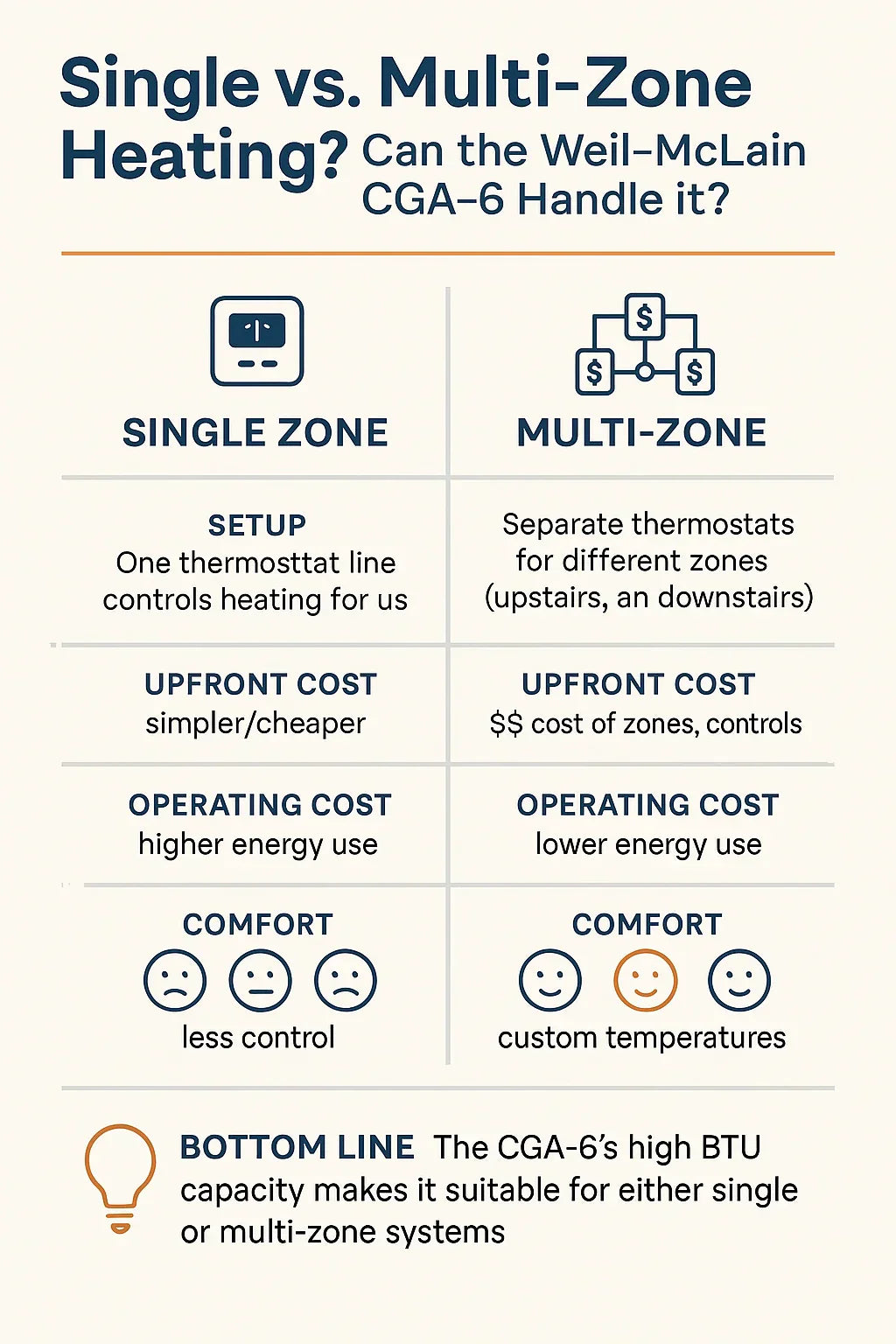When I upgraded my home heating system, one of the toughest decisions I faced wasn’t just which boiler to buy, but how to configure it. Should I stick with a single-zone setup for simplicity, or invest in a multi-zone system for more precise control?
If you’re considering the Weil-McLain CGA-6 Series 3 166,000 BTU Cast Iron Natural Gas Boiler, you’ve already chosen a powerful workhorse. But the real magic happens when you decide how to deliver that heat throughout your home. In this guide, I’ll break down single vs. multi-zone heating in detail and show you how the CGA-6 performs in each scenario.
📏 What Does Zoning Mean in Home Heating?
-
Single-zone heating: One thermostat, one loop, one temperature across the house.
-
Multi-zone heating: Multiple thermostats, valves or pumps controlling separate areas (floors, wings, or even individual rooms).
👉 Think of zoning like lighting circuits in your home. One switch controls all the lights (single-zone), or each room has its own switch (multi-zone).
🔗 Heating system zoning basics from Energy.gov
🔥 The Weil-McLain CGA-6: A Boiler Built for Both
At 166,000 BTUs, the CGA-6 is sized for large homes (3,000–5,000 sq. ft.) or smaller multi-family properties.
-
Strong enough to support 4–6 heating zones without straining.
-
Compatible with circulator pumps or zone valves.
-
Works equally well in single large-loop setups.
This flexibility is what makes it so appealing to homeowners like me—you can grow into a multi-zone system without replacing the boiler.
🟢 Pros & Cons of Single-Zone Heating
✅ Advantages
-
Lower upfront cost (fewer pumps, valves, thermostats).
-
Simpler installation and maintenance.
-
Works fine in open-layout or smaller homes.
❌ Drawbacks
-
Wasted energy heating unused rooms.
-
Uneven comfort—upstairs too hot, downstairs too cold.
-
No ability to customize temperatures per area.
👉 Example: A 3,000 sq. ft. ranch home in Georgia might do fine with a single zone because winters are mild and the layout is even.
🟡 Pros & Cons of Multi-Zone Heating
✅ Advantages
-
Customized comfort (different temps for bedrooms, living spaces).
-
Improved efficiency (heat only occupied areas).
-
Adds resale value in larger homes.
-
Works beautifully with smart thermostats.
❌ Drawbacks
-
Higher upfront cost (extra pumps/valves + wiring).
-
More complexity = more potential repairs.
-
Slightly longer install timeline.
👉 Example: A 3,500 sq. ft. colonial in New Jersey with three floors benefits greatly from 3–4 zones, since basement, first floor, and bedrooms have different heat needs.
🔗 Caleffi Hydronics on zoning best practices
🧮 How the CGA-6 Handles Multi-Zone Loads
With 166,000 BTUs, the CGA-6 can:
-
Supply 4–6 zones comfortably.
-
Run multiple circulator pumps (one per zone).
-
Or use zone valves with a single pump + controller.
-
Maintain strong output even in cold climates.
💡 Samantha’s Tip: Oversizing isn’t as dangerous in a multi-zone system because heat demand is staggered across zones—your boiler isn’t blasting the entire house at once.
⚙️ Components Needed for Zoning
-
Thermostats: $100–$400 each (or $250–$500 for smart).
-
Circulator pumps: $300–$700 each.
-
Zone valves: $150–$300 each (if you use valve-based zoning).
-
Controller board: $200–$400.
-
Extra piping & labor: varies, but typically $1,500–$3,000 total for a 3–4 zone upgrade.
🔗 HeatingHelp: Zone valves vs. circulator pumps
💵 Cost Comparison: Single vs. Multi-Zone
| Setup | Upfront Cost | Operating Cost | Comfort Level |
|---|---|---|---|
| Single Zone | $9,000–$11,000 | Higher (wasted heat) | Fair |
| Multi-Zone (3–4) | $11,000–$14,000 | Lower (targeted heating) | Excellent |
| Multi-Zone (5–6) | $13,000–$16,000 | Lowest in big homes | Excellent+ |
💡 While multi-zone adds upfront cost, it usually pays back in 5–7 years through energy savings.
🧑🔧 When to Choose Single-Zone with the CGA-6
-
Homes under 3,000 sq. ft. with open layouts.
-
Mild climate regions where heating is secondary.
-
Rental properties where simplicity = less maintenance.
🏠 When to Choose Multi-Zone with the CGA-6
-
Multi-story homes (2+ floors).
-
Larger homes (3,000–5,000 sq. ft.).
-
Families with varying comfort needs (bedrooms cooler, living spaces warmer).
-
Energy-conscious homeowners wanting to reduce waste.
📝 Samantha’s Real-World Example
In my 3,400 sq. ft. colonial in Pennsylvania:
-
Old system: 1 zone, uneven temps (basement freezing, upstairs sauna).
-
Upgrade: CGA-6 + 4 zones (basement, first floor, second floor, attic office).
-
Added cost: ~$2,500 for pumps, valves, thermostats.
-
Result:
-
18% drop in annual gas bills.
-
Happier family (no more “too hot” vs. “too cold” battles).
-
ROI in under 6 years.
-
✅ Key Takeaways
-
The Weil-McLain CGA-6 (166,000 BTU) is strong enough for either single-zone or multi-zone setups.
-
Single-zone = cheaper upfront, better for smaller or simpler homes.
-
Multi-zone = higher upfront cost, but long-term savings + maximum comfort.
-
Expect to add $1,500–$3,000 per zone in extra parts and labor.
-
Samantha’s advice: If your home is over 3,000 sq. ft. or multi-story, go multi-zone—you won’t regret it.
In the next topic we will know more about: Installation Guide: What Samantha Learned About Putting in a Weil-McLain Gas Boiler







